MITSUBISHI 3000GT 1991 Service Manual
Manufacturer: MITSUBISHI, Model Year: 1991, Model line: 3000GT, Model: MITSUBISHI 3000GT 1991Pages: 1146, PDF Size: 76.68 MB
Page 491 of 1146
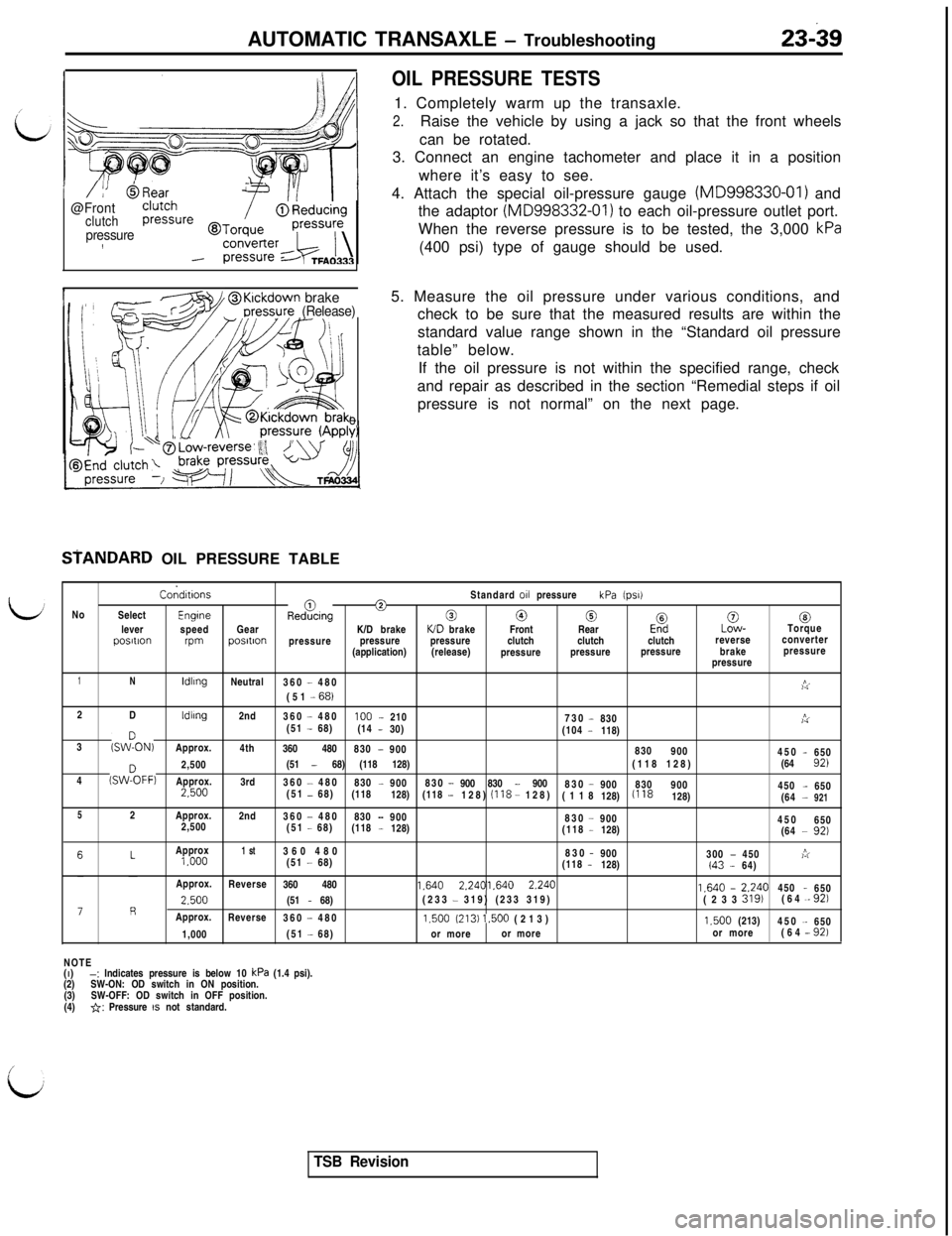
AUTOMATIC TRANSAXLE - Troubleshooting23-39
//!’ 6Rear@FrontclutchpressureI
@Kickdown brakeoressure (Release)
e
OIL PRESSURE TESTS1. Completely warm up the transaxle.
2.Raise the vehicle by using a jack so that the front wheels
can be rotated.
3. Connect an engine tachometer and place it in a position
where it’s easy to see.
4. Attach the special oil-pressure gauge (MD998330-01) and
the adaptor (MD998332-01) to each oil-pressure outlet port.
When the reverse pressure is to be tested, the 3,000
kPa(400 psi) type of gauge should be used.
5. Measure the oil pressure under various conditions, and
check to be sure that the measured results are within the
standard value range shown in the “Standard oil pressure
table” below.
If the oil pressure is not within the specified range, check
and repair as described in the section “Remedial steps if oil
pressure is not normal” on the next page.
STANDARD OIL PRESSURE TABLECondtttonsStandard
011 pressurekPa (PSI)No
SelectEngme
Red&g@000E%00leverspeedGearK/D brakeWD brakeFrontRearLow-TorqueposItlollvposltlon
pressurepressurepressureclutchclutchclutchreverseconverter
(application)(release)
pressurepressurepressurebrakepressure
pressure
1Nldlmg
Neutral
360 - 4808,(51 - 6812
Dldlmg
2nd
360
- 480100-210
730 -830k(51 - 68)
(14-30)
(104 -118)
3(SWFON,
Approx.
4th
360 480
830
-900
830
900
450-650
2,500(51 - 68) (118 128)(118 128)(64 92)
(SWZFF)Approx.
3rd
360 - 480
830
900830 -900 830 - 900
830 -900830
900
450-4
650-2.500(51 - 68)
(118
128)(118 -128) (118 - 128)
(118
128)(118128)
(64-921
52
Approx.
2nd
360
- 480
830--900
830 -900
450
650
2,500
(51 - 68)
(118-128)
(118 -128)
(64-921
Approx
1 st360 480
830 -900
300-450A1.000(51 - 68)
(118 -128)I43 .-64)
Approx.
Reverse
360 480
1.6402.2401.640 2.2401.640 -2.240450-6502.500(51 - 68)(233 - 319) (233 319)(233 319)(64 ~- 921
Approx.
Reverse
360
- 4801.500(213) 1.500 (213)1.500(213)
450~-650
1,000(51 - 68)or moreor moreor more(64 - 92)NOTE
(I)
-: Indicates pressure is below 10 kPa (1.4 psi).
(2)SW-ON: OD switch in ON position.
(3)SW-OFF: OD switch in OFF position.
(4)
a: Pressure IS not standard.
TSB Revision
Page 492 of 1146
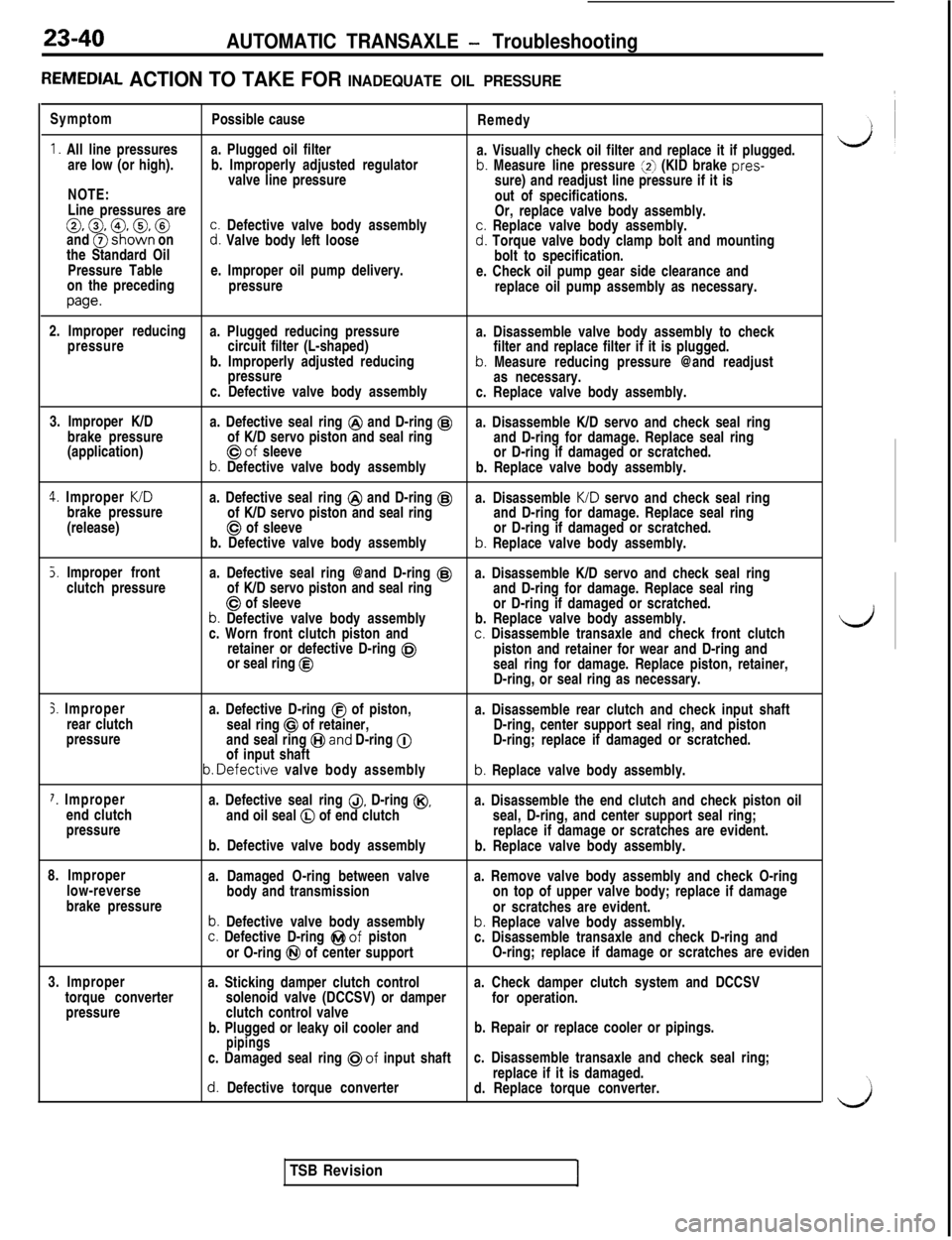
23-40AUTOMATIC TRANSAXLE - Troubleshooting
REMEDIAL ACTION TO TAKE FOR INADEQUATE OIL PRESSURESymptom
Possible cause
Remedy
1. All line pressuresa. Plugged oil filter
are low (or high).b. Improperly adjusted regulatora. Visually check oil filter and replace it if plugged.
valve line pressure
b. Measure line pressure (2) (KID brake pres-
NOTE:sure) and readjust line pressure if it is
Line pressures areout of specifications.
@.@.@).@.@and @shown onc. Defective valve body assemblyOr, replace valve body assembly.
the Standard Oil
Pressure Table
on the preceding
paw.
d. Valve body left loose
e. Improper oil pump delivery.
pressurec. Replace valve body assembly.d. Torque valve body clamp bolt and mounting
bolt to specification.
e. Check oil pump gear side clearance and
replace oil pump assembly as necessary.
2. Improper reducing
a. Plugged reducing pressure
a. Disassemble valve body assembly to check
pressurecircuit filter (L-shaped)
b. Improperly adjusted reducingfilter and replace filter if it is plugged.
b. Measure reducing pressure @and readjust
pressure
c. Defective valve body assemblyas necessary.
c. Replace valve body assembly.
3. Improper K/D
brake pressure
(application)a. Defective seal ring
@ and D-ring @of K/D servo piston and seal ringa. Disassemble K/D servo and check seal ring
@of sleeveand D-ring for damage. Replace seal ringb. Defective valve body assemblyor D-ring if damaged or scratched.
b. Replace valve body assembly.
4. Improper KIDbrake pressure
(release)
J. Improper front
clutch pressurea. Defective seal ring
@ and D-ring @of K/D servo piston and seal ringa. Disassemble KID servo and check seal ring
@ of sleeveand D-ring for damage. Replace seal ring
b. Defective valve body assemblyor D-ring if damaged or scratched.b. Replace valve body assembly.
a. Defective seal ring @and D-ring
@of K/D servo piston and seal ringa. Disassemble K/D servo and check seal ring
@ of sleeveand D-ring for damage. Replace seal ringb. Defective valve body assemblyor D-ring if damaged or scratched.
c. Worn front clutch piston andb. Replace valve body assembly.c. Disassemble transaxle and check front clutch
retainer or defective D-ring @or seal ring @piston and retainer for wear and D-ring and
seal ring for damage. Replace piston, retainer,
D-ring, or seal ring as necessary.
3. Improper
rear clutch
pressure
7. Improper
end clutch
pressurea. Defective D-ring
@ of piston,
seal ring @ of retainer,
and seal ring @and D-ring @of input shaft
b. Defectrve valve body assembly
a. Defective seal ring
0. D-ring 0,and oil seal (iJ of end clutch
b. Defective valve body assemblya. Disassemble rear clutch and check input shaft
D-ring, center support seal ring, and piston
D-ring; replace if damaged or scratched.
b. Replace valve body assembly.
a. Disassemble the end clutch and check piston oil
seal, D-ring, and center support seal ring;
replace if damage or scratches are evident.
b. Replace valve body assembly.
8. Improper
low-reverse
brake pressurea. Damaged O-ring between valve
body and transmission
b. Defective valve body assemblyc. Defective D-ring @of piston
or O-ring
@I of center supporta. Remove valve body assembly and check O-ring
on top of upper valve body; replace if damage
or scratches are evident.
b. Replace valve body assembly.
c. Disassemble transaxle and check D-ring and
O-ring; replace if damage or scratches are eviden
3. Improper
torque converter
pressurea. Sticking damper clutch controla. Check damper clutch system and DCCSV
solenoid valve (DCCSV) or damper
for operation.
clutch control valve
b. Plugged or leaky oil cooler and
pipingsb. Repair or replace cooler or pipings.
c. Damaged seal ring @of input shaftc. Disassemble transaxle and check seal ring;
d. Defective torque converterreplace if it is damaged.
d. Replace torque converter.
TSB Revision
d
‘\
d
Page 493 of 1146
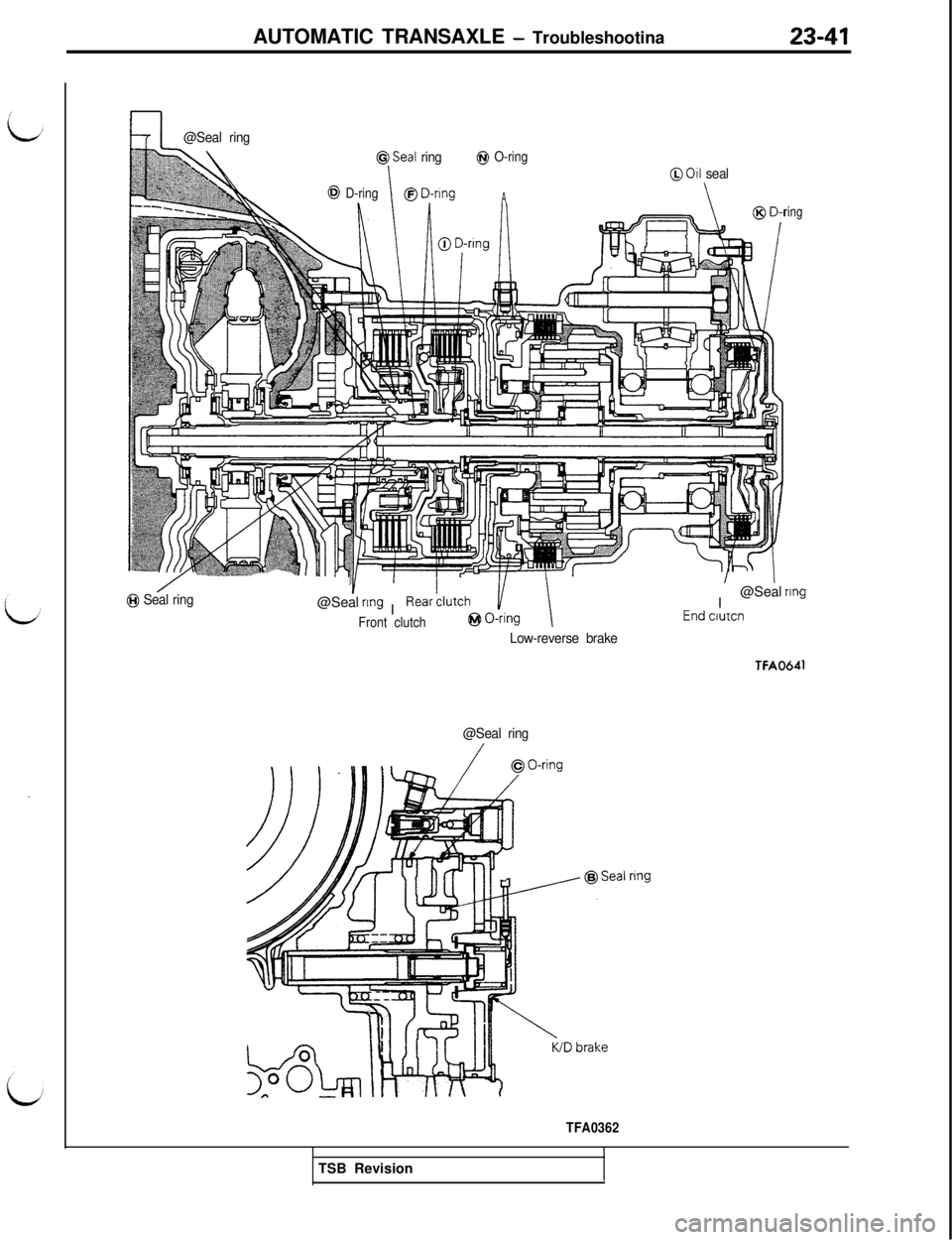
AUTOMATIC TRANSAXLE - Troubleshootina23-41
L-l@Seal ring
$&-g&J\@Seal ring@I O-ring!A>. .Yr&w
\
@ 011 seal
h.43 D-ring@ D-rmgA\ring
/@I Seal ring@Seal rmgI
Front clutchI@Seal
rmg
rItna cIuIcn
Low-reverse brake
TFA0641
@Seal ring
/
TFA0362TSB Revision
Page 494 of 1146
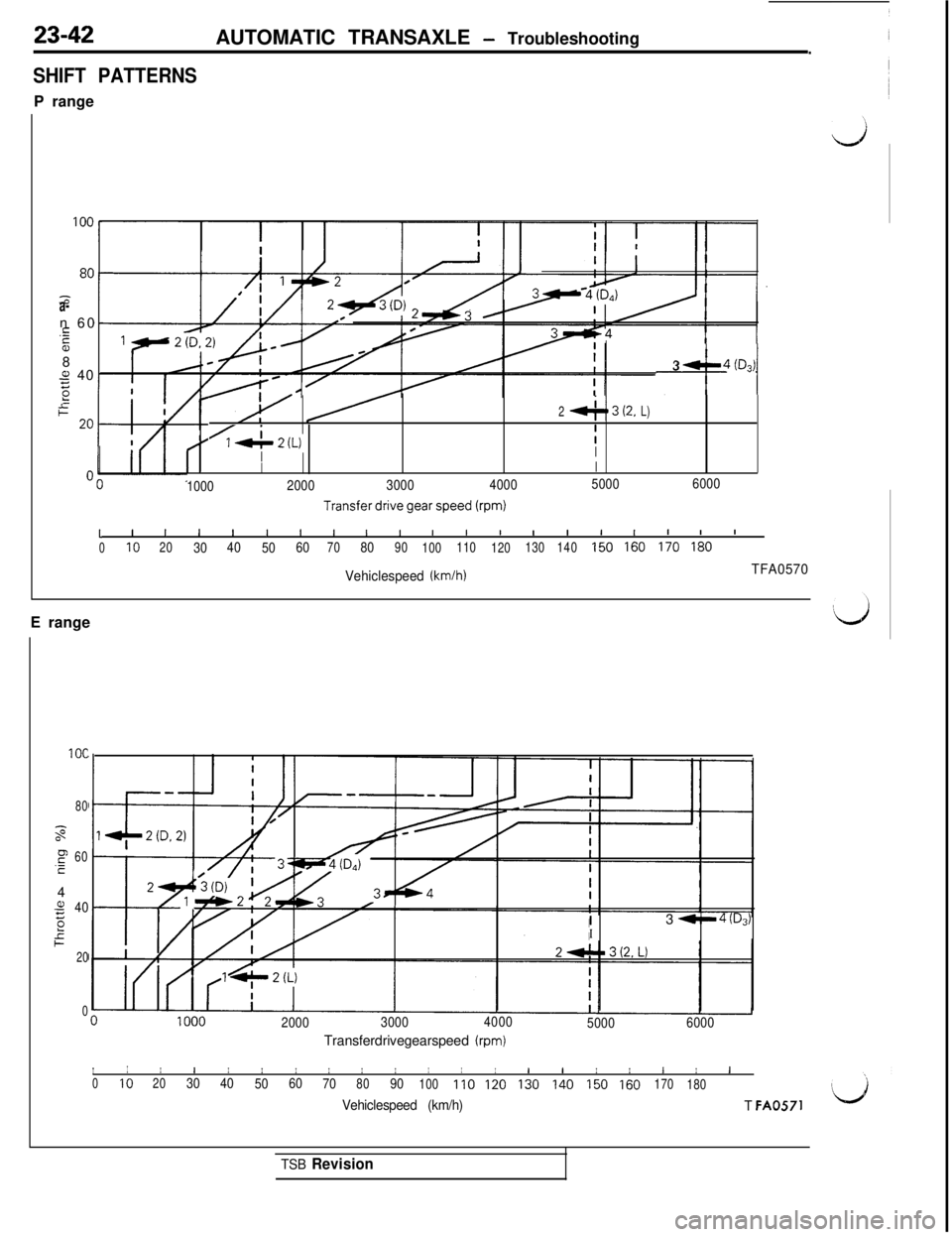
23-42AUTOMATIC TRANSAXLE - Troubleshooting.
SHIFT PATTERNSP range
-i;a-n 60
.rs
8
-z" 405
-+-!
34(b)
2413(2,L)
IIII
100020003000400050006000Transferdrivegearspeedtrpm)
IIIIIIIIIIIIIIIIIIII
010203040
5060708090
100110
120130140150160170180
Vehiclespeed (km/h)TFA0570E range
IOC
80-z
6
F60'E4
$40
5E
20
0
I3 e-4 (DAI
200030004000
50006000Transferdrivegearspeed
(rpm)
IIIIIIIIIIII
IIIIIIII010203040
5060
708090100110120130140150160170
180
Vehiclespeed (km/h)
T FA0571
TSB Revision
Page 495 of 1146
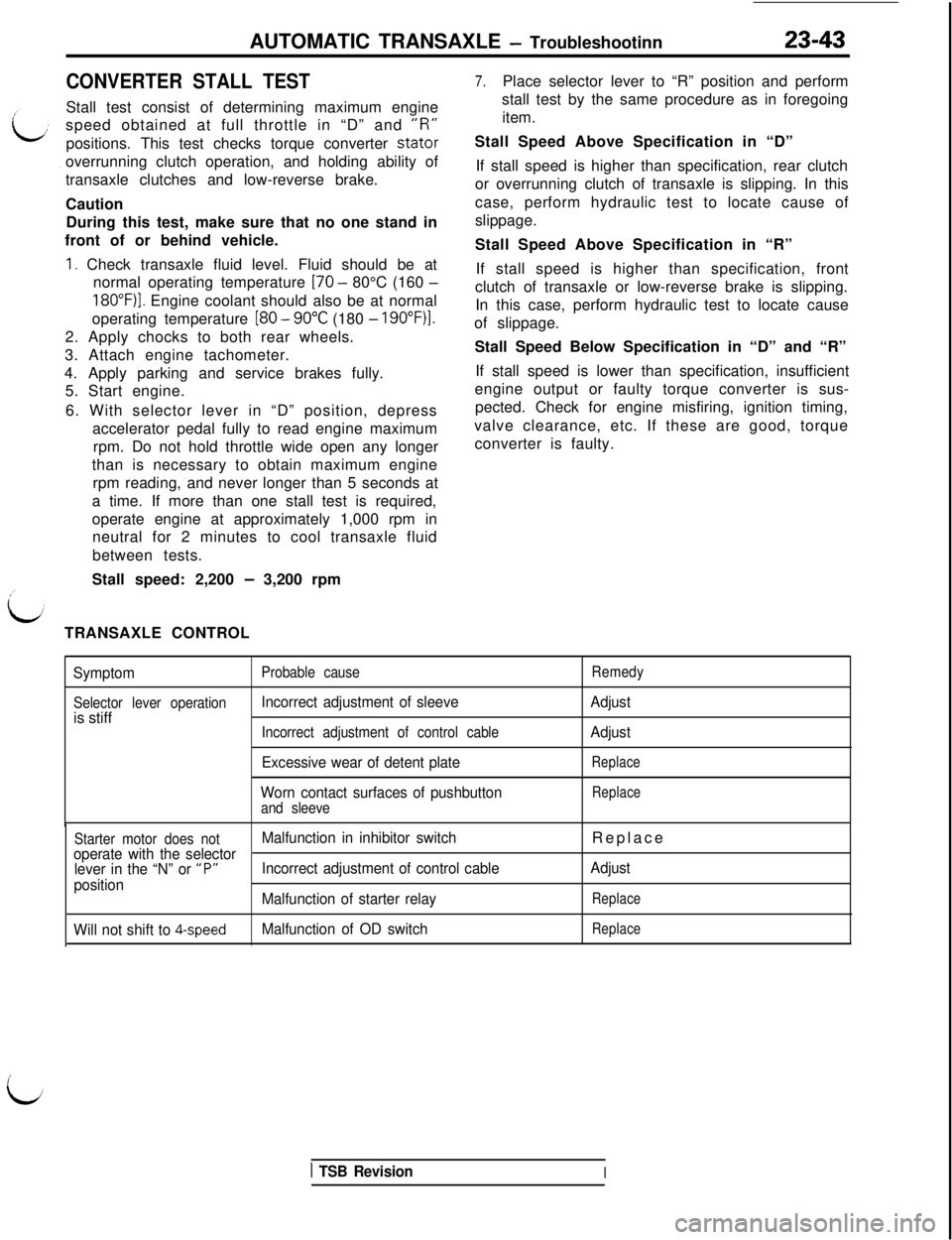
AUTOMATIC TRANSAXLE - Troubleshootinn23-43
CONVERTER STALL TESTStall test consist of determining maximum engine
speed obtained at full throttle in “D” and
“I?”positions. This test checks torque converter
statoroverrunning clutch operation, and holding ability of
transaxle clutches and low-reverse brake.
Caution
During this test, make sure that no one stand in
front of or behind vehicle.
1. Check transaxle fluid level. Fluid should be at
normal operating temperature
[70 - 80°C (160 -
18O”F)I. Engine coolant should also be at normal
operating temperature
[80 - 90°C (180 - 19O”F)l.2. Apply chocks to both rear wheels.
3. Attach engine tachometer.
4. Apply parking and service brakes fully.
5. Start engine.
6. With selector lever in “D” position, depress
accelerator pedal fully to read engine maximum
rpm. Do not hold throttle wide open any longer
than is necessary to obtain maximum engine
rpm reading, and never longer than 5 seconds at
a time. If more than one stall test is required,
operate engine at approximately 1,000 rpm in
neutral for 2 minutes to cool transaxle fluid
between tests.
Stall speed: 2,200
- 3,200 rpm
7.Place selector lever to “R” position and perform
stall test by the same procedure as in foregoing
item.
Stall Speed Above Specification in “D”
If stall speed is higher than specification, rear clutch
or overrunning clutch of transaxle is slipping. In this
case, perform hydraulic test to locate cause of
slippage.
Stall Speed Above Specification in “R”
If stall speed is higher than specification, front
clutch of transaxle or low-reverse brake is slipping.
In this case, perform hydraulic test to locate cause
of slippage.
Stall Speed Below Specification in “D” and “R”
If stall speed is lower than specification, insufficient
engine output or faulty torque converter is sus-
pected. Check for engine misfiring, ignition timing,
valve clearance, etc. If these are good, torque
converter is faulty.
TRANSAXLE CONTROL
Symptom
Selector lever operationis stiff
Probable cause
Incorrect adjustment of sleeve
Remedy
Adjust
Incorrect adjustment of control cable
Excessive wear of detent plate
Worn contact surfaces of pushbutton
and sleeve
Adjust
Replace
Replace
Starter motor does notMalfunction in inhibitor switchReplace
operate with the selector
lever in the “N” or “P”Incorrect adjustment of control cableAdjust
position
Will not shift to
4-speed
Malfunction of starter relay
Malfunction of OD switchReplace
Replace
1 TSB RevisionI
Page 496 of 1146
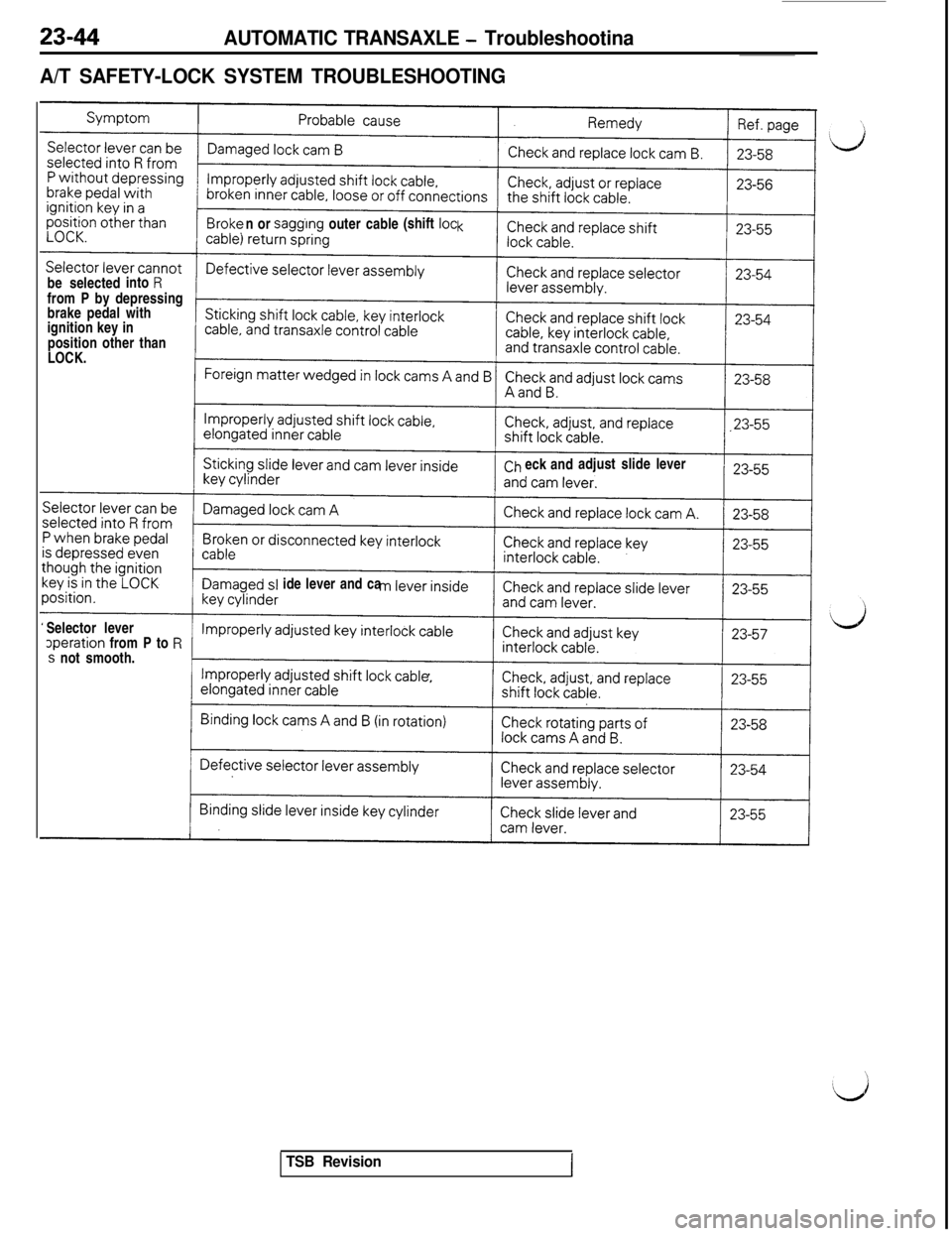
23-44AUTOMATIC TRANSAXLE - Troubleshootina
A/T SAFETY-LOCK SYSTEM TROUBLESHOOTINGbe selectedinto
Rfrom P by depressing
brake pedal with
ignition key in
position other than
LOCK.n or sagging outer cable(shift
loteck andadjust slide lever
ide lever and ca
Selector lever
Iperation from P to Rs not smooth.
TSB Revision
Page 497 of 1146

AUTOMATIC TRANSAXLE - Troubleshooting23-45Symptom
Probable cause
RemedyRef. page
Selector lever cannot
be shifted from
R to P.Defective selector lever assembly
Check and replace selector23-54
lever assembly.
Improperly adjusted transaxle control cable
Adjust transaxle control
23-56
cable.Ignition key cannot
Foreign matter wedged in lock cams A and B
23-58
be turned to LOCKCheck and replace lock cams
A and B.
position with selector
lever in
P.Improperly adjusted key interlock cable,
sticking inner cableCheck, adjust, and replace213-55key interlock cable.
Binding slide lever inside key cylinder
Check slide lever.
23-55
Ignition key can be
Damaged lock cam A
Check and replace lock cam A.
2:3-58turned to LOCK
position even withLoose key cylinder cover
Check and retighten cover.
2:3-55selector lever in
position other than P.
Broken key interlock cable, loose connec-
Check and replace key
2355tions, elongated inner cable
interlock cable.
Damaged cam lever inside key cylinder
Check and replace cam lever.
2:3-55Buzzer does not soundDefective buzzer
Check and replace buzzer.
2:3-55even when selector
lever is placed in
ROpen-circuited buzzer circuit harness
Check or correct harness.-position.
Defective inhibitor switchCheck and replace inhibitor
-switch.
Improperly adjusted transaxle control cableAdjust transaxle control
2:3-52
cable.
TSB Revision
Page 498 of 1146
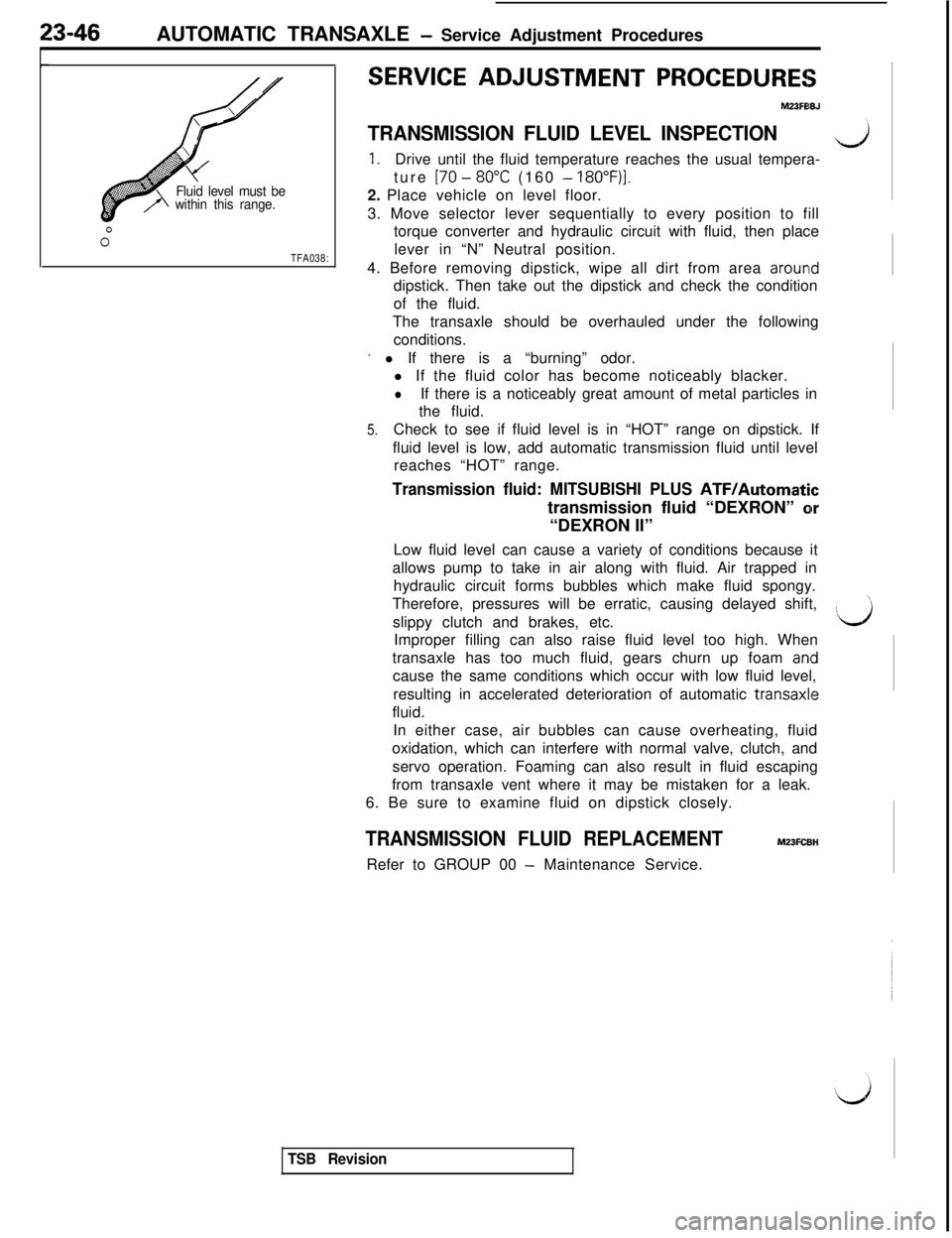
23-46AUTOMATIC TRANSAXLE - Service Adjustment Procedures
Fluid level must be
within this range.
TFA038:
SERVICE ADJUSTMENT PROCEDURE!5
MZ3FElBJ
TRANSMISSION FLUID LEVEL INSPECTION
1.Drive until the fluid temperature reaches the usual tempera-
ture
170 - 80°C (160 - 18O”F)].2. Place vehicle on level floor.
3. Move selector lever sequentially to every position to fill
torque converter and hydraulic circuit with fluid, then place
lever in “N” Neutral position.
4. Before removing dipstick, wipe all dirt from area
arouniddipstick. Then take out the dipstick and check the condition
of the fluid.
The transaxle should be overhauled under the following
conditions.
’ l If there is a “burning” odor.
l If the fluid color has become noticeably blacker.
lIf there is a noticeably great amount of metal particles in
the fluid.
5.Check to see if fluid level is in “HOT” range on dipstick. If
fluid level is low, add automatic transmission fluid until level
reaches “HOT” range.
Transmission fluid: MITSUBISHI PLUS ATF/Automatictransmission fluid “DEXRON”
abr“DEXRON II”
Low fluid level can cause a variety of conditions because it
allows pump to take in air along with fluid. Air trapped in
hydraulic circuit forms bubbles which make fluid spongy.
Therefore, pressures will be erratic, causing delayed shift,
slippy clutch and brakes, etc.
Improper filling can also raise fluid level too high. When
transaxle has too much fluid, gears churn up foam
anldcause the same conditions which occur with low fluid level,
resulting in accelerated deterioration of automatic
transaxllefluid.
In either case, air bubbles can cause overheating, fluid
oxidation, which can interfere with normal valve, clutch, and
servo operation. Foaming can also result in fluid escaping
from transaxle vent where it may be mistaken for a leak.
6. Be sure to examine fluid on dipstick closely.
TRANSMISSION FLUID REPLACEMENTM23FCBHRefer to GROUP 00
- Maintenance Service.
TSB Revision
Page 499 of 1146
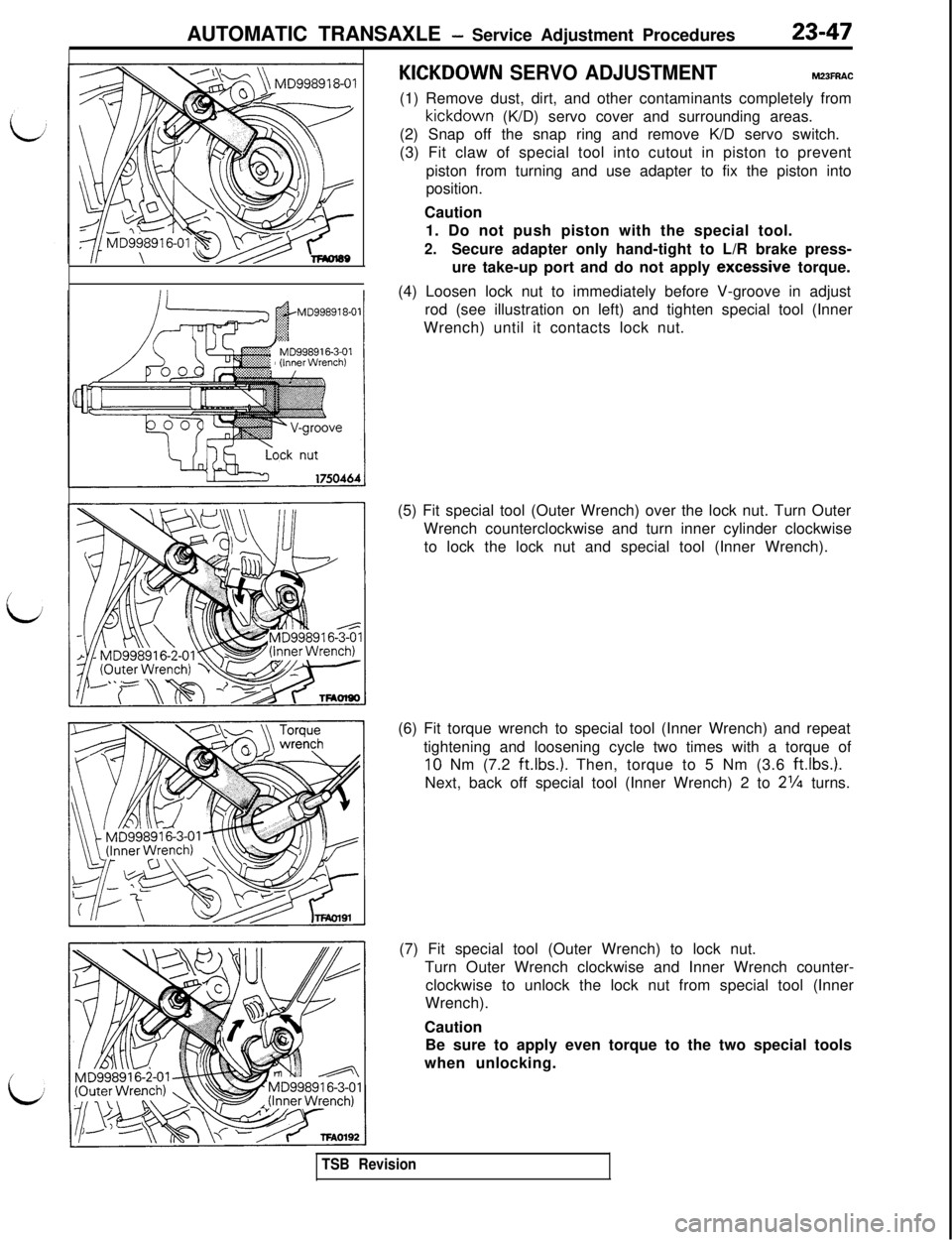
AUTOMATIC TRANSAXLE - Service Adjustment Procedures23-47
MD998916-3-01
KICKDOWN SERVO ADJUSTMENTM23FRAC(1) Remove dust, dirt, and other contaminants completely fromkickdown (K/D) servo cover and surrounding areas.
(2) Snap off the snap ring and remove K/D servo switch.
(3) Fit claw of special tool into cutout in piston to prevent
piston from turning and use adapter to fix the piston into
position.
Caution
1. Do not push piston with the special tool.
2.Secure adapter only hand-tight to L/R brake press-
ure take-up port and do not apply
excessiwe torque.
(4) Loosen lock nut to immediately before V-groove in adjust
rod (see illustration on left) and tighten special tool (Inner
Wrench) until it contacts lock nut.
(5) Fit special tool (Outer Wrench) over the lock nut. Turn Outer
Wrench counterclockwise and turn inner cylinder clockwise
to lock the lock nut and special tool (Inner Wrench).
(6) Fit torque wrench to special tool (Inner Wrench) and repeat
tightening and loosening cycle two times with a torque of
10 Nm (7.2 ft.lbs.). Then, torque to 5 Nm (3.6 ftlbs.).Next, back off special tool (Inner Wrench) 2 to
2’/4 turns.
(7) Fit special tool (Outer Wrench) to lock nut.
Turn Outer Wrench clockwise and Inner Wrench counter-
clockwise to unlock the lock nut from special tool (Inner
Wrench).
Caution
Be sure to apply even torque to the two special tools
when unlocking.
TSB Revision
Page 500 of 1146
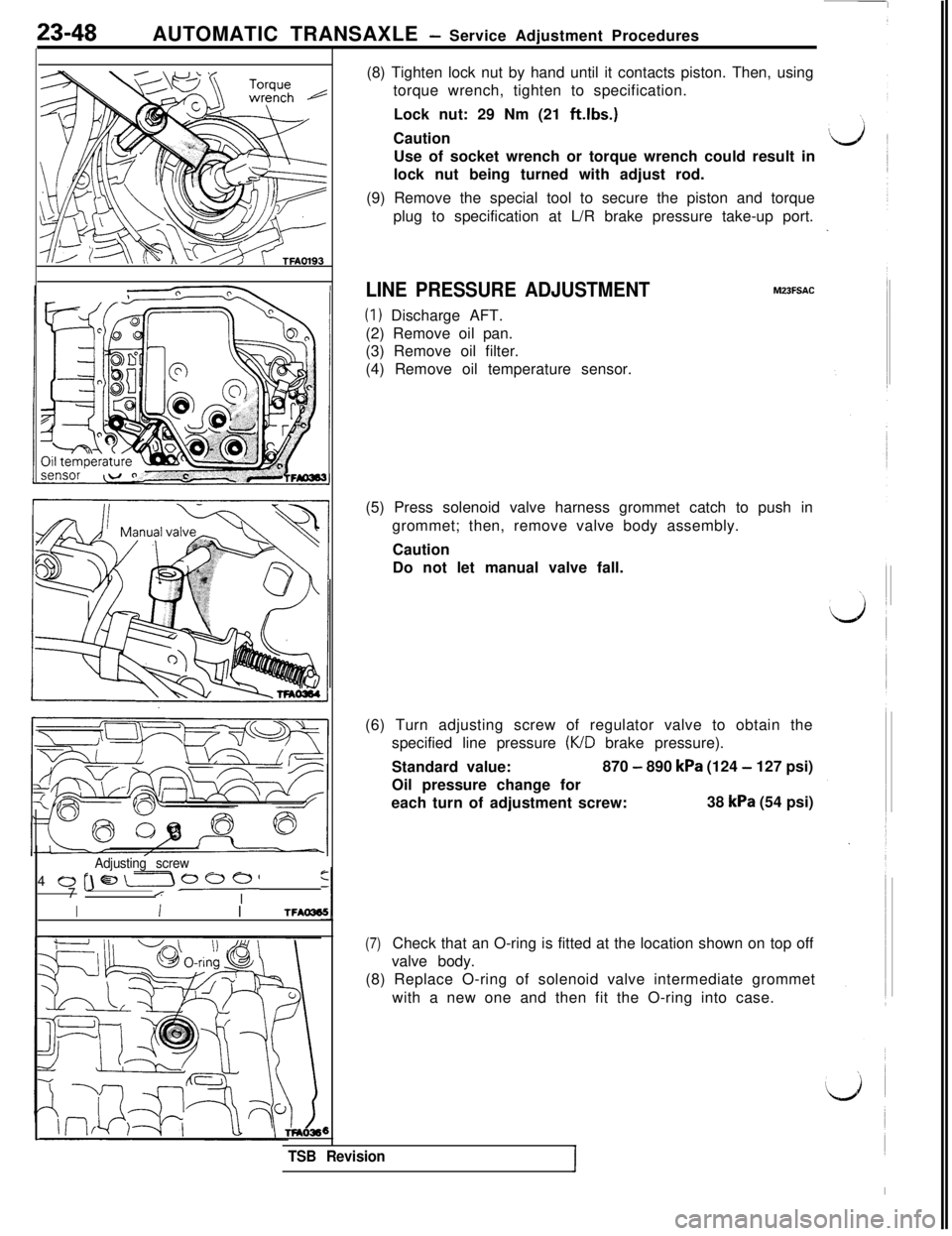
23-48AUTOMATIC TRANSAXLE - Service Adjustment Procedures
Adjusting screw4
or~0\====m00~7/IIIITFAm
c-1
Pi(8) Tighten lock nut by hand until it contacts piston. Then, using
torque wrench, tighten to specification.
Lock nut: 29 Nm (21
ftlbs.)Caution
Use of socket wrench or torque wrench could result in
lock nut being turned with adjust rod.
(9) Remove the special tool to secure the piston and torque
plug to specification at L/R brake pressure take-up port.
LINE PRESSURE ADJUSTMENT
(I) Discharge AFT.
(2) Remove oil pan.
(3) Remove oil filter.
(4) Remove oil temperature sensor.
M23FSAC(5) Press solenoid valve harness grommet catch to push in
grommet; then, remove valve body assembly.
Caution
Do not let manual valve fall.
(6) Turn adjusting screw of regulator valve to obtain the
specified line pressure
(K/D brake pressure).
Standard value:870
- 890 kPa (124 - 127 psi)
Oil pressure change for
each turn of adjustment screw:38
kPa (54 psi)
(7)Check that an O-ring is fitted at the location shown on top off
valve body.
(8) Replace O-ring of solenoid valve intermediate grommet
with a new one and then fit the O-ring into case.6
TSB RevisionI